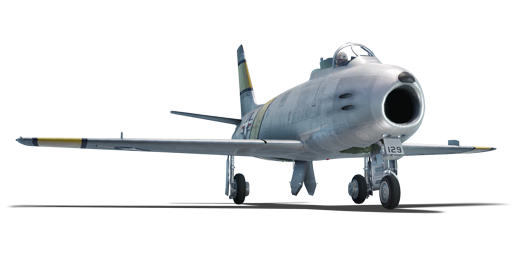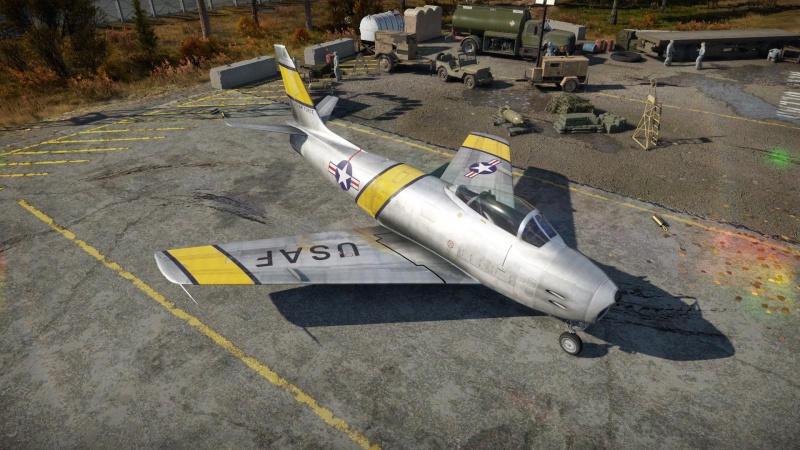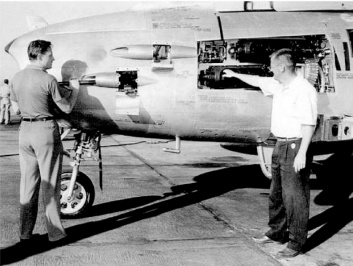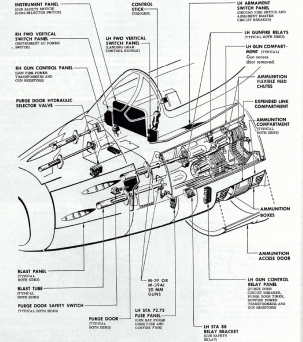F-86F-2
| This page is about the American jet fighter F-86F-2. For other variants, see F-86 (Family). |
Contents
Description
The F-86F-2 Sabre is a rank VI American jet fighter with a battle rating of 9.0 (AB/SB) and 8.7 (RB). It was introduced in Update 1.35.
General info
Flight performance
| Characteristics | Max Speed (km/h at 0 m - sea level) |
Max altitude (metres) |
Turn time (seconds) |
Rate of climb (metres/second) |
Take-off run (metres) | |||
|---|---|---|---|---|---|---|---|---|
| AB | RB | AB | RB | AB | RB | |||
| Stock | 1,095 | 1,089 | 14700 | 24.7 | 25.9 | 38.8 | 35.9 | 750 |
| Upgraded | 1,115 | 1,106 | 23.6 | 24.0 | 56.5 | 46.7 | ||
Details
| Features | |||||
|---|---|---|---|---|---|
| Combat flaps | Take-off flaps | Landing flaps | Air brakes | Arrestor gear | Drogue chute |
| ✓ | ✓ | ✓ | ✓ | X | X |
| Limits | ||||||
|---|---|---|---|---|---|---|
| Wings (km/h) | Gear (km/h) | Flaps (km/h) | Max Static G | |||
| Combat | Take-off | Landing | + | - | ||
| 0 | 350 | 590 | 550 | 350 | ~11 | ~6 |
| Optimal velocities (km/h) | |||
|---|---|---|---|
| Ailerons | Rudder | Elevators | Radiator |
| < 850 | < 600 | < 650 | N/A |
Engine performance
| Engine | Aircraft mass | |||||
|---|---|---|---|---|---|---|
| Engine name | Number | Empty mass | Wing loading (full fuel) | |||
| General Electric J47-GE-27 | 1 | 5,570 kg | 243 kg/m2 | |||
| Engine characteristics | Mass with fuel (no weapons load) | Max Takeoff Weight | ||||
| Weight (each) | Type | 7m fuel | 20m fuel | 26m fuel | ||
| 1,150 kg | Axial-flow turbojet | 5,927 kg | 6,569 kg | 6,866 kg | 9,530 kg | |
| Maximum engine thrust @ 0 m (RB / SB) | Thrust to weight ratio @ 0 m (100%) | |||||
| Condition | 100% | WEP | 7m fuel | 20m fuel | 26m fuel | MTOW |
| Stationary | 2,626 kgf | N/A | 0.44 | 0.40 | 0.38 | 0.28 |
| Optimal | 2,626 kgf (0 km/h) |
N/A | 0.44 | 0.40 | 0.38 | 0.28 |
Survivability and armour
- 6.35 mm steel - in front of cockpit
- 12.7 mm steel - behind pilot
- 38 mm bulletproof glass - armoured windscreen
- 20 mm steel pilot's headrest
Modifications and economy
Armaments
Offensive armament
The F-86F-2 is armed with:
- 4 x 20 mm FMC T-160 cannons, nose-mounted (115 rpg = 460 total)
Suspended armament
The F-86F-2 can be outfitted with the following ordnance:
- Without load
- 16 x HVAR rockets
- 2 x 1,000 lb AN-M65A1 Fin M129 bombs (2,000 lb total)
Usage in battles
In Jet RB, speed is life, and doubly so for sabres. First thing that should be done after takeoff is gaining at least 1,000 km/h IAS in level flight and assessing the match. If in a downtier, staying on the deck is advisable as you will be one of the fastest planes in the battle. Focus on anyone who can match or exceed your speed and then move on to everyone else once there are no other threats. In an uptier, gain 1-2 km of altitude and play an assasin type role. Make it your mission to kill out of position players while using the threat of your one-shot potential to dissuade enemies from attacking you and nearby teammates. Maintaining at least 800 km/h is very important because of the Sabre's comparatively poor handling at lower speed compared to MiGs, G91s, and the like. High speed passes are the main tactic, avoid prolonged dogfights which bleed your speed unless absolutely necessary, as the plane's mid to low speed handling and terrible acceleration leaves something to be desired against some of its more nimble opposition.
The plane's biggest strength and its specialty are the four T-160 revolver cannons it carries. These guns are simply the best in their class, and none of the F-2's contemporaries can boast such a powerful and easy to utilize gun platform. What this means is that the F-2 is an excellent aircraft for punishing other players' mistakes, no matter how small. One note about the guns is that the extreme fire rate demands trigger patience. If you're struggling with ammo conservation, focus on lining up your shots and firing 10-15 rounds accurately at a target rather than hosing half your ammo load for the chance at a crit. The guns will be kind to you if you use them properly. F-2 pilots should always be on the offensive whenever possible to take advantage of the plane's huge impact on the battlefield. By continually maintaining a high energy state and eliminating out of position targets, the F-2 can dominate entire lobbies even in full uptiers.
Radars
The F-86F-2 is equipped with an AN/APG-30 rangefinding radar, located in the nose of the aircraft. It will automatically detect other planes within the scanning area and display the range to the closest target. It is linked with a gyro gunsight and can help with aiming at close range.
| AN/APG-30 - Rangefinding radar | |||
|---|---|---|---|
| Maximum Tracking Range |
Minimum Tracking Range |
Azimuth Tracking Angle |
Elevation Tracking Angle |
| 2,750 m | 300 m | ±9° | ±9° |
Pros and cons
Pros:
- Very fast roll rate
- Very accurate high-velocity cannons with huge fire density
- Excels overall at high-speed manoeuvres, good for snapshots
- Good rate of turn in the horizontal
- Good zooming ability
- Can take ordnance (almost never recommended, though it is nice to have the utility)
- Phenomenal high speed energy retention
Cons:
- Low firing time of 4.62 seconds total
- Poor low speed acceleration
- Even when spaded, the guns have terrible spread
History
The "Gun Val" Project
As is well-known, most F-86 Sabre fighters of the USAF that joined the Korean War had six AN/M3 12.7 mm machine guns as their basic weapon configuration against enemy aircraft. Although the experience of the European battlefield during World War II showed that an average of 300 12.7 mm bullets could shoot down an enemy aircraft, the US pilots found that sometimes their 12.7 mm machine guns couldn't easily shoot down enemy MiG fighters even when they scored many hits on them. Though there were also many F-86 fighters that successfully returned to the airfield when they were hit by the 23 mm or 37 mm cannon of the MiG-15 fighter, there was no doubt that the USAF needed a new airborne weapon to replace the aged 12.7 mm machine gun.
Although the USAF had successfully introduced the M24A1 20 mm cannon, the Air Force's version of the Navy's AN/M3 20 mm cannon, on the Convair B-36 Peacemaker strategic bomber, they don't want to simply introduce the old 20 mm cannon to the F-86F Sabre fighter because its rate of fire (700-800 rounds per minute) was found unsuitable for modern air combat. Therefore, a research project named "Gun Val" was established on April 3rd 1951 to find out the most suitable cannon which could be incorporated into current Sabre fighter and the incoming Century Series aircraft. (Other aircraft such as F-94B, F-84F, and F-89C also participated in the Gun Val program).
North American Aviation Company delivered four F-86E-10 and six F-86F-1 Sabre fighters to Air Material Command to test the newly developed T-160 20×102 mm cannon. The T-160 cannon was a single-barreled revolver cannon which was an imitation of the captured German MG213C 20 mm revolver cannon, the latter had been transported to the USA in 1946. Thanks to the cooperation of Springfield Arsenal and the Illinois Institute of Technology, the initial development work of the T-160 cannon was finished in the early 1950s, and it was put into the production line in June 1951. It was a gas-operated, belt-fed, electrically fired weapon, the cannon was capable of firing electrically primed ammunition at a rate of 1,500 rounds per minute and developed a muzzle velocity of 3,250 feet per second. There were five types of 20×102 mm cartridges available for the T-160 cannon, including M55A1 and M55A2 ball, M53 Armour-piercing Incendiary and M56 High-Explosive Incendiary ammunition.
Another cannon joining the competition with the T-160 cannon was the Oerlikon 206 RK 20 mm cannon which was also a revolver gun, capable of firing electrically primed ammunition at the rate of 1,650 rounds per minute and a muzzle velocity of 3,500 feet per second which were both higher than T-160 cannon.
The 10 Sabre fighters fitted with four T-160 cannons were called F-86F-2 while two Sabre fighters with four Oerlikon 206 RK cannons were called F-86F-3. As for the F-86F-3, the USAF didn't receive any of them until April 1954, and the final test report, finished in February 1955, outlined that the Oerlikon 206 RK cannon had lots of problems that needed to be solved before it entered into service, such as poor round dispersion of the gun and installation problems. Though the company claimed that these problems could be solved in the future, at that time the M39 revolver cannon had been put into mass production many years ago, so not surprisingly that the Oerlikon program was canceled in the end.
As a comparison, those ten F-86F-2 fighters equipped with T-160 cannon were much luckier. Apart from the cannon, all F-86F-2 fighters were fitted with new 6-3 wing, and both the original A-4 gun/rocket/bomb calculating sight and the AN/APG-30 ranging radar remained. After the initial test was done, Lieutenant Colonel Peterson who was the project officer of Gun Val program at that time decided to take eight F-86F-2 fighters to Korea aboard the USS Windham Bay for combat trials in December 1952.
All the F-86F-2 fighters were assigned to the 335th FIS of 4th Fighter Wing at Kimpo, and only six aircraft were ever actually in Korea at any one time. When they arrived at Kimpo, these F-86F-2 fighters were re-painted as other original F-86F Sabre fighter such as the black and yellow FEAF ID bands and yellow and black tail stripe. Ground crews also painted the third gun port on the nose under the two 20 mm muzzle to make them looks indistinguishable with the original machine gun-armed F-86F Sabre fighter. Apart from that, the commander of F-86F-2 team was changed to Colonel Garrison, but Peterson was still stayed there as a contractor technician with other three contractor technicians and five assigned pilots.
The combat trial began in January 1953, though it was discovered that the cannon gas from the 20 mm cannon may cause a compressor stall which was very dangerous for both plane and its pilot, including one accident when Major Moorehead fired his 20 mm cannon in a long burst during one mission and caused the engine stop working, though he was able to restart the engine, the problem appeared again later. But even with the Sabre pilots only using two cannons at a time to avoid the problem, they still fired almost 10,900 rounds in combat, engaged MiG fighters in 41 missions and successfully shot down six of them (3 MiG fighters were probably destroyed and 13 MiG fighters damaged) with two F-86F-2 were damaged (one's intake was hit by the 37 mm shell and another one's wing was hit by the 23 mm shell), but unfortunately Captain Moore's plane suffered a flame-out accident followed by turbine failure on 30th April 1953, so he had to bail out in the end.
To solve these problems, Peterson not only sent the report to the test center, but also found a way to simply solve the problem: a simple horseshoe clip installed in the blast tube of the cannon broke up the cannon gas before it could enter the intake. The Gun Val combat trial program was finished on May 1953, and in order to completely solve the cannon gas problem, the engineers of North American Aviation company invented a C-shaped plate which could effectively dissipated the cannon gas, this solution was finally adopted for operational use on the late version of F-86H fighter with four M39 cannons.
Inspire by the success of the Gun Val program, USAF finally decided to accept the T-160 cannon as its next-generation air-combat weapon and renamed it as M39 20 mm cannon. The first operational fighter equip with M39 cannon was North American Aviation F-86H-5 Sabre fighter in mid 1950s, then it became the standard internal weapon on both North American Aviation F-100 Super Sabre fighter, McDonnell F-101A Voodoo long-range escort fighter and Northrop F-5 fighter.
Media
See also
- Related development
- Canadair Sabre (those Sabres manufactured with the designator "CL")
- North American F-86A/F
- North American F-86D Sabre
- North American F-100 Super Sabre
- North American FJ-4 Fury
- Aircraft of comparable role, configuration and era
- Dassault Super Mystère
- Grumman F-9 Cougar
- Hawker Hunter
- Lavochkin La-15
- Mikoyan-Gurevich MiG-15
- Mikoyan-Gurevich MiG-17
- Saab J29 Tunnan
- Canadair CL-13A MK5
- Canadair CL-13B Mk6
External links
| North American Aviation | |
|---|---|
| Fighters | |
| P-51A | P-51 · P-51A |
| P-51C | P-51C-10 |
| P-51D | P-51D-5 · P-51D-10 · P-51D-20-NA · P-51D-30 |
| P-51H | P-51H-5-NA |
| Twin-engine fighters | F-82E |
| Jet fighters | F-86A-5 · F-86F-2 · F-86F-25 · F-86F-35 · F-100D |
| Strike aircraft | A-36 · PBJ-1H · PBJ-1J |
| FJ-4B · FJ-4B VMF-232 | |
| Bombers | B-25J-1 · B-25J-20 |
| Export/Licence | ▂B-25J-30 · ␗B-25J-30 |
| ▄Mustang Mk IA · F-6C-10-NA · ␗P-51C-11-NT · ␗P-51D-20 · J26 David · J26 · P-51D-20-NA · ␗P-51K | |
| F-86F-30 ▅ · ␗F-86F-30 · F-86F-40 ▅ · F-86F-40 JASDF▅ · ␗F-86F-40 | |
| ◄F-86K · ▄F-86K (Italy) · ▄F-86K (France) | |
| ␗F-100A · ▄F-100D · ␗F-100F | |
| Captured | ▅P-51C-11-NT |
| Canadair Limited license-built the F-86 as the CL-13 for use in Canada and export to Europe. | |
| Fiat license-built the F-86K for the Italian Air Force though another 120 NAA built F-86Ks were also sold to the Italians. | |
| See Also | Mitsubishi Heavy Industries · Canadair Limited · Fiat Aviation |
| USA jet aircraft | |
|---|---|
| Fighters | |
| F9F | F9F-2 · F9F-5 · F9F-8 |
| F-80 | F-80A-5 · F-80C-10 |
| F-84 | F-84B-26 · F-84F · F-84G-21-RE |
| F-86 | F-86A-5 · F-86F-25 · F-86F-2 · F-86F-35 |
| F-89 | F-89B · F-89D |
| F-100 | F-100D |
| F-104 | F-104A · F-104C |
| F-4 | F-4C Phantom II · F-4E Phantom II · F-4J Phantom II · F-4S Phantom II |
| F-5 | F-5A · F-5C · F-5E · F-20A |
| F-8 | F8U-2 · F-8E |
| F-14 | F-14A Early · ▄F-14A IRIAF · F-14B |
| F-15 | F-15A · F-15C MSIP II · F-15E |
| F-16 | F-16A · F-16A ADF · F-16C |
| Other | P-59A · F2H-2 · F3D-1 · F3H-2 · F4D-1 · F11F-1 |
| Strike Aircraft | |
| FJ-4 | FJ-4B · FJ-4B VMF-232 |
| A-4 | A-4B · A-4E Early |
| A-7 | A-7D · A-7E · A-7K |
| AV-8 | AV-8A · AV-8C · AV-8B Plus · AV-8B (NA) |
| A-10 | A-10A · A-10A Late · A-10C |
| F-111 | F-111A · F-111F |
| Other | A-6E TRAM · F-105D · F-117 |
| Bombers | |
| B-57 | B-57A · B-57B |







